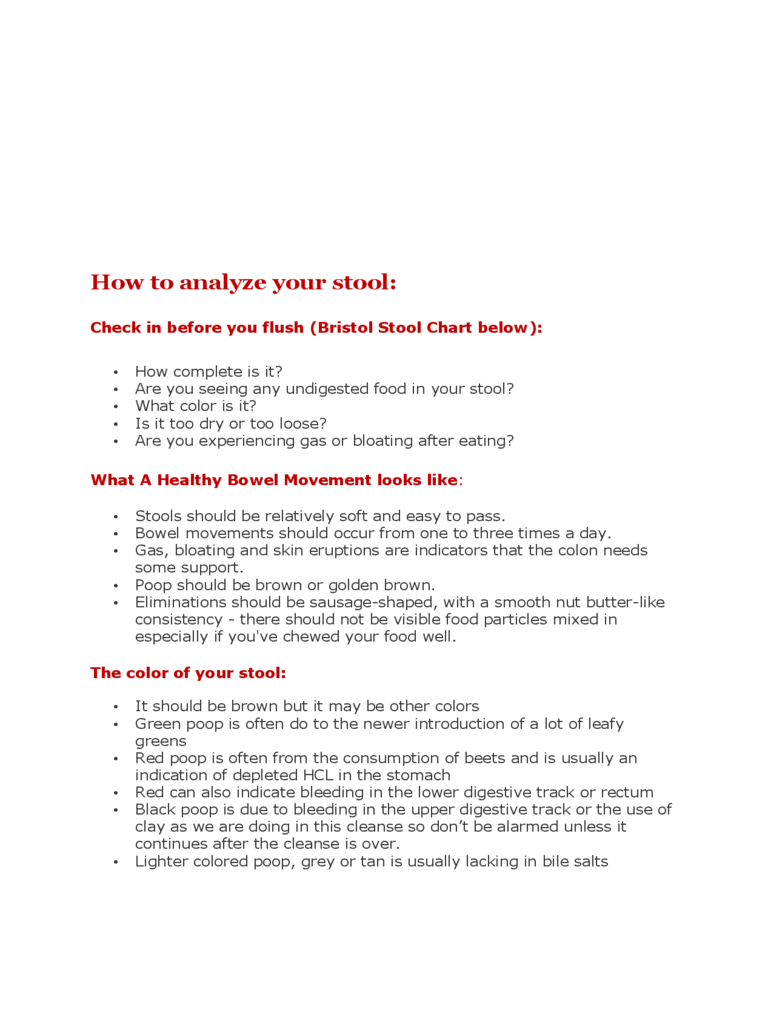Fillable Printable Stool Color Guide and Chart
Fillable Printable Stool Color Guide and Chart

Stool Color Guide and Chart

How to analyze your stool:
Check in before you flush (Bristol Stool Chart below):
• How complete is it?
• Are you seeing any undigested food in your stool?
• What color is it?
• Is it too dry or too loose?
• Are you experiencing gas or bloating after eating?
What A Healthy Bowel Movement looks like:
• Stools should be relatively soft and easy to pass.
• Bowel movements should occur from one to three times a day.
• Gas, bloating and skin eruptions are indicators that the colon needs
some support.
• Poop should be brown or golden brown.
• Eliminations should be sausage-shaped, with a smooth nut butter-like
consistency - there should not be visible food particles mixed in
especially if you've chewed your food well.
The color of your stool:
•
It should be brown but it may be other colors
•
Green poop is often do to the newer introduction of a lot of leafy
greens
•
Red poop is often from the consumption of beets and is usually an
indication of depleted HCL in the stomach
•
Red can also indicate bleeding in the lower digestive track or rectum
•
Black poop is due to bleeding in the upper digestive track or the use of
clay as we are doing in this cleanse so don’t be alarmed unless it
continues after the cleanse is over.
•
Lighter colored poop, grey or tan is usually lacking in bile salts


Bristol Stool Form Scale
» Type 1: Separate hard lumps, like nuts
This type is a sure sign you are constipated Typical for post-antibiotic
treatments and for people attempting fiber-free (low-carb) diets.
» Type 2: Sausage-like but lumpy
This is a sign of toxic constipation. Represents a combination of Type 1
stools impacted into a single mass and lumped together by fiber
components and some bacteria. This type leads to hemorrhoids. To
attain this form, the stools must be in the colon for at least a week,
maybe more, instead of the normal 72 hours. This person is in need of
intestinal cleansing
» Type 3: Like a sausage but with cracks in the surface
(Normal)
» Type 4: Like a sausage or snake, smooth and soft (Normal)
This form is normal for someone defecating 1-3 times a day after
meals.
» Type 5: Soft blobs with clear-cut edges (Borderline Normal)
If they are too soft it may indicate you ate something that irritated
you bowel.
» Type 6: Fluffy pieces with ragged edges, a mushy stool
This indicates some toxins in the colon. Can be the result of laxatives
or too much magnesium. Make changes in your diet to get it back to
normal.
» Type 7: Watery, no solid pieces
This, of course, is diarrhea, passing through the colon quickly. You
may have a viral or bacterial infection. Check with your doctor if it
continues.
Changes in your stool are common and are generally not significant if the
changes are noted from one stool to the next and are not persistent.
However, changes in the color and texture of stool can also be caused by a
number of minor to serious medical conditions and can occur with certain
medications. Changes in stool that are persistent and occur regularly may
signal the presence of a medical condition and should be evaluated.



